The Best Medium Format Film Cameras to Buy in 2025
![]()
The past decade has seen an explosion of film users. Whether this is driven by a sense of nostalgia, or a desire to experience the past (for those too young to have shot film earlier in their life), for the simplicity, or perhaps because some celebrities have taken to shooting film, it doesn’t really matter. The reality is likely a combination of many factors.
Nonetheless, we are consistently seeing rising prices for film cameras on the used market (as well as vintage lenses). New producers of film enter the market frequently and both black and white and color 35mm, 120 (medium format), and 4×5 film are readily available.
We previously put together a guide that explored options for those seeking options for great 35mm cameras. Now, we’ll explore the wide world of medium format, which today is shot on what is known as “120 film” and generally comes in five sizes: 6×4.5, 6×6, 6×7, 6×8, and 6x9cm. These represent anywhere from about 2.62 to 5.41 times the size of 35mm film (or “full-frame” digital). With high-quality lenses and fine-grained film, a large medium format negative can resolve impeccable detail.
We have broken options down into three categories (SLRs, TLRs, and rangefinders) with three price-based subcategories within those (Budget, Mid-Range, and Premium). While there are some very budget options, such as the Seagull 4A or Lubitel TLRs, I find no point in recommending mediocre (or downright awful), unreliable cameras simply because they are the absolute cheapest.
Thus, these choices are a combination of system cost, availability, and quality. Similarly, not every category is created equal — rangefinders are inherently more expensive than SLRs or TLRs, which naturally shifts the price scale upward. There are dozens upon dozens of brands and models not listed here — this is an inherent trait of any guide of this nature and choices must be made. This isn’t a slight against those not included, but simply a reflection of my personal choices based on very extensive experience with just about any camera you can name.
While used cameras can come from a variety of sources, quality can vary. In our opinion, the best U.S.-based sources for vintage cameras are Robert’s Camera (UsedPhotoPro) in Indianapolis, Indiana, and KEH Camera in Smyrna, Georgia. Both offer six-month warranties and free shipping on a majority of products.
At a Glance
Single-Lens Reflex (SLR) Cameras
Budget: Mamiya 645 Series
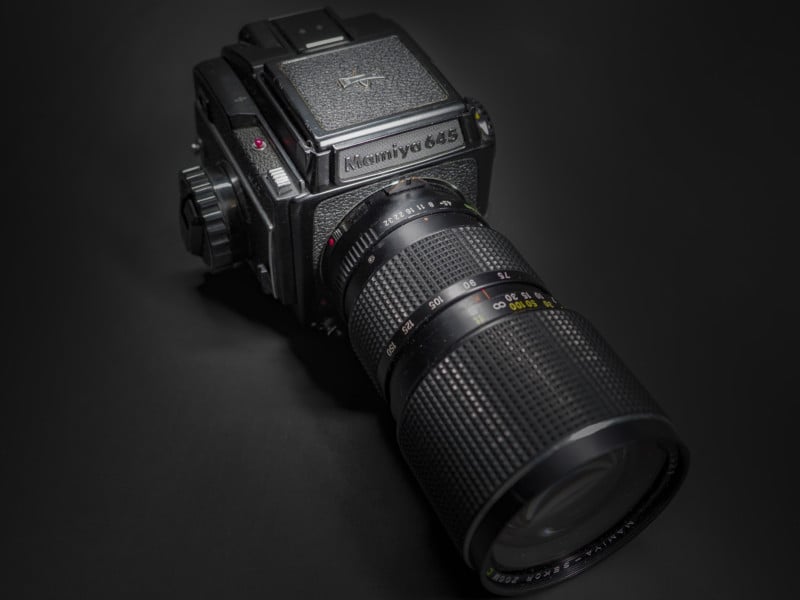
Mamiya, at the time known for its C series of 6x6cm TLRs, Mamiya Six, Mamiya Press, and RB67 6x7cm medium format cameras released its first 6×4.5cm camera body in 1975. The 645 format had not been used in forty years, making the Mamiya 645 the first medium format SLR to use the 645 format, which allowed for 15 shots on 120, or 30 on 220 (the more popular 6×6 format would produce 12 shots on 120 and 24 on 220).
There were three generations of Mamiya 645 cameras. The first included the M645, M645 1000S, and M645 J; the second introduced the 645 Super, 645 Pro, 645 Pro-TL, and 645E; the third and final generation adopted an autofocus system and, in the late 2000s, partnered with Phase One to function with digital medium format backs — some of these work with current Mamiya Leaf and Phase One backs.
While the second-generation Pro bodies are excellent, they are certainly not budget options. However, the original M645, and successor M645 1000S, are quite affordable. The only difference is a bump from a top shutter speed of 1/500 in the M645 to 1/1000 in the 1000S.
Unlike most other medium format bodies of the time, the first-generation Mamiya 645 bodies do not have interchangeable backs. This isn’t a big disadvantage in practice, but some photographers do like the ability to swap to different film stocks before finishing a roll. The bodies do, however, have interchangeable finders: two waist-level (one with a sports finder, one without), an unmetered eye-level prism, three metered prisms (varying differences), and one metered AE prism. The latter allows for aperture-priority autoexposure in addition to regular manual. The waist-level finders command the highest prices, generally.
Additionally, five interchangeable focusing screens — matte, microprism, checker, rangefinder spot with microprism, and rangefinder spot — are available, along with additional accessories such pistol handgrips (with and without shutter trigger) and a power drive grip with automatic film advance.
The standard and most common lens to find paired with a Mamiya M645 is the Sekor C or Sekor N 80/2.8. The Sekor 55/2.8, 120/4 APO Macro, 145/4, 150/3.5, 55-110/4.5, and 105-210/4.5 are all very affordable options. The Sekor C and Sekor N 80mm f/1.9 is the fastest lens in the lineup and among the fastest medium format lenses ever made.
With a huge library of lenses — which also work on higher-end models like the Mamiya 645 Pro, should you choose to upgrade later — and one of the most affordable bodies on the market, you really can’t go wrong here. Mamiya 645 lens adapters are also readily available for just about any DSLR or mirrorless mount out there.
Mid-Range: Pentax 6×7 / Pentax 6×7 MLU
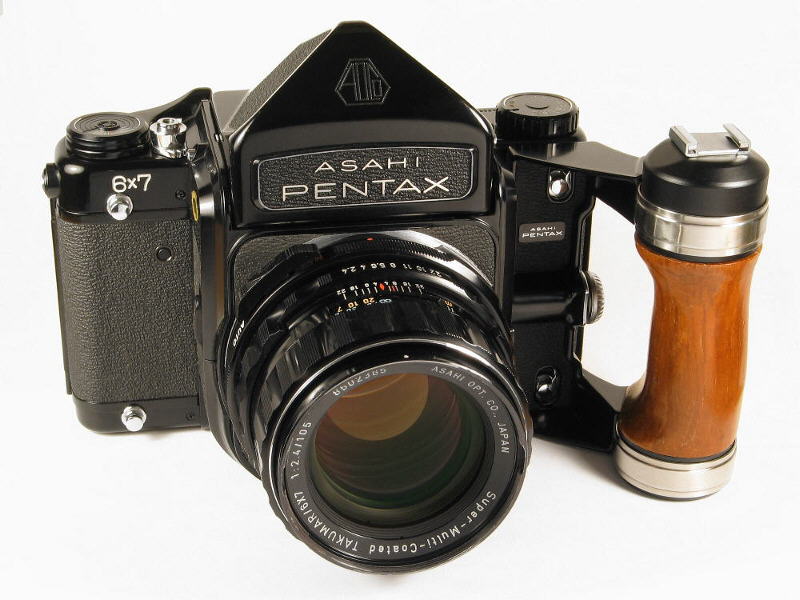
In 1969, Asahi Pentax released one of the few medium format cameras that essentially operates like a massive 35mm SLR. From the traditional pentaprism finder shape to the lever-operated film advance, the DNA of standard 35mm SLRs is clear from the get.
The first model — the Asahi Pentax 6×7, also sold as the Honeywell Pentax 6×7 in North America — produced 60mm x 70mm images (actually closer to 56mm due to the film’s rebate edge) on either 120 (10 frames) or 220 film (20 frames). The body is a hulking beast, weighing in at 5.1 pounds with the plain unmetered prism and standard 105mm f/2.4 lens. Like many medium format cameras, the prism is interchangeable — as is the focusing screen — with waist-level and TTL (through-the-lens) metered prism options in addition to the standard prism. Furthermore, to aid with the handling, there is a rather iconic and very fashionable left-handed accessory wood grip available.
The Asahi Pentax 6×7 was followed by the Asahi Pentax 6×7 MLU in 1976, the Pentax 67 in 1990, and the Pentax 67 II in 1999. The 6×7 MLU is identical to the original 6×7, but with a mirror lock-up mechanism. This proves very useful for tripod-based landscape, still-life, or slow shutter speed work — the gigantic mirror kicks like a mule and while it is incredibly pleasing in an acoustic sense, it is quite prone to causing vibration-induced blur.
There is a wide range of lenses available for the system: the Pentax Takumar 105/2.4 being the standard “kit” lens and one of the jewels of the system. Pentax 6×7 or Pentax 67 lenses overall tend to be very affordable — the SMC Takumar 45/4, 55/3.5, 55/4, 75/4.5, 150/2.8, 200/4, 55-100/4.5, and 90-180/5.6 are all quite cheap, with some of them easily found for under or around $100. Like the Mamiya 645 series, there are adapters to just about every DSLR or mirrorless mount for Pentax 6×7 lenses.
The Pentax 6×7 is one of my favorite medium format cameras. Though I doubt it is much heavier (and possibly lighter) than other 6×7 cameras like the Bronica GS-1 or Mamiya RB/RZ67, it is extremely dense, and its SLR-like form factor seems to belie its heft. It’ll give you a workout, but it’s worth it.
Premium: Hasselblad 500 Series
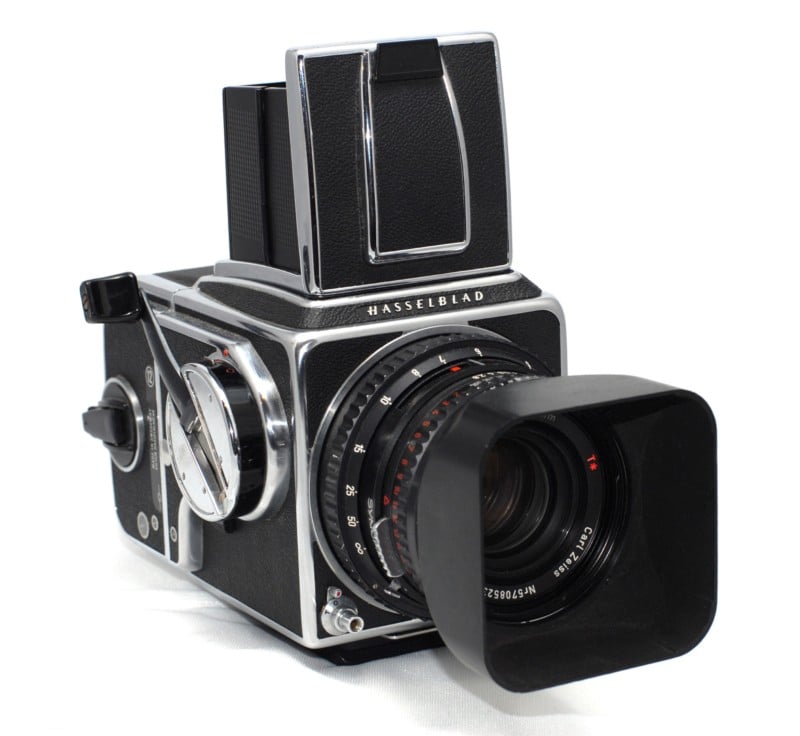
What photographer hasn’t heard of Hasselblad? The Swedish manufacturer is up there with Leica and Zeiss in the pantheon of the camera greats. And the Hasselblad 500 series is, arguably, what launched them to greatness.
Before the 500 series, Hasselblad developed what it called “the ideal camera” in the late 1940s — a 6×6 medium format camera known as the 1600F, followed soon after by the 1000F. Its modular design, with interchangeable lenses, viewfinders, winders, and film backs, was revolutionary. TLRs dominated the medium format market and none, at the time, had any of those capabilities.
In 1957, Hasselblad debuted the 500C, the first model in its new series of cameras using interchangeable leaf-shutter lenses, eliminating the issues inherent in the focal plane shutter of the 1600F/1000F and allowing flash synchronization at every speed. A modified variation of the 500C would become the first camera to see outer space in the Apollo and Gemini flights.
From the introduction of the 500C, Hasselblad issued incremental upgrades in new models — the 500C/M, 501C, and 501CM are probably the most popular — ending with the 503CW which ceased production in 2013. These models formed the core of the Hasselblad “V System,” a name that only came about once Hasselblad released the “H System” in 2002 in order to differentiate the two. While the V System includes cameras outside the 500 series, none are as desirable nor as iconic.
While the bodies are highly regarded for their build quality, reliability, ergonomics, and aesthetics, it is arguably the line of incredible lenses that raise the Hasselblads to another level. There are over 70 lenses in the V system, though a good number of these are updated models of the same lens — the C and C T* lenses are the earliest, while the CF, CF FLE, and CF IHI lenses came about later.
With one exception, all C and C T* lenses were made by Carl Zeiss, making for the ultimate fusion of two photography titans. The earlier Zeiss C lenses feature a black, anti-reflection coating on the inside, and those manufactured from 1959 to 1974 were single-coated. In 1973, Zeiss began to implement its famous T* multicoating to the lenses, hence the C T* — this makes for improved flare control, greater contrast, and improved transmission (T-stop).
Lenses range from a 30/3.5 F-Distagon (17mm FF-equivalent) to a 500/8 Tele-Tessar (275mm FF-equivalent), with the Zeiss 80/2.8 Planar being the “standard” lens. There was also one zoom lens, the Schneider 140-280/5.6 Variogon, which is quite rare to find.
With some of the most extensive lens options to possibly the widest and most versatile selection of accessories of any medium format system, the V system’s 500 series are the best SLR medium format cameras you can buy. To top it off, the 500 series is compatible with many medium format digital backs, including the current CFV II 50C.
Twin-Lens Reflex (TLR) Cameras
While most of us know what an SLR (“Single Lens Reflex”) is, the concept of a TLR is more foreign to many since their design was not carried over to the digital age. TLR (“Twin Lens Reflex”) cameras use, as you might assume from the name, two lenses — almost always mounted vertically. The top lens, known as the “viewing lens,” passes light onto a mirror, which then bounces the image onto the ground glass — exactly how an SLR works. These cameras are almost always used with a waist-level finder, which the photographer looks down into to view the projected image, thus allowing them to frame and focus.
The bottom lens, known as the “taking lens,” is an identical focal length (though the aperture, which is always wide open, may be slightly different) and contains a leaf shutter. This lens, upon firing the shutter, projects an image directly onto the film. The advantages between a TLR and SLR are numerous in the medium format world: the bodies can be smaller and lighter, they are overall significantly simpler to manufacture (and repair) with fewer points of failure, there is no viewfinder blackout, and they are quieter and more inconspicuous by an order of magnitude — there is no loud, slapping mirror and the leaf shutter is nearly silent, virtually vibration-free, and can flash sync at any speed.
The primary disadvantages of TLRs are a lack of interchangeable lenses (with two exceptions), no zoom lenses, a lack of interchangeable finders (with few exceptions), a lack of interchangeable backs, a laterally reversed image in the viewfinder, and that parallax error is a problem at close-focus distances, much like a rangefinder. Also, almost all TLRs use the 6×6 format, though some offer adapters for 35mm film to allow for wide-aspect ratio images.
Budget: Minolta Autocord Series
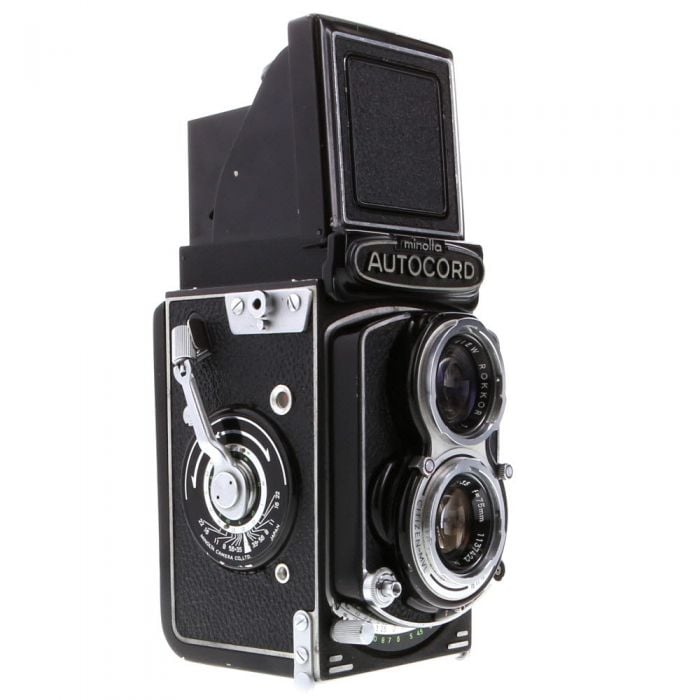
After the Second World War, Japan saw the most impressive collective effort at reconstruction the world had ever seen, and by the mid-1950s, the premium TLR market was quite crowded. Chiyoda Kogaku Seiko K.K. (“Chiyoda Optics and Precision Industry Co., Ltd.) released its answer in 1955: the Minolta Autocord MXS. That same year also saw the introduction of the Autocord MXV and Autocord L — the latter moved from an Optiper to Seikosha Rapid shutter with an increased top speed of 1/500, up from 1/400. It was also fitted with a selenium meter.
Between 1955 and 1966 at least seventeen models of the Autocord hit the market. Differences from one to the next were usually minor, but all Autocords shared a few major features: a renowned 4 element/3 group Tessar-type 75mm f/3.5 Rokkor lens, shutter speeds down to one second, a crank advance with automatic shutter cocking and frame counting, and the ability to cock the shutter without advancing the film (allowing for double exposures).
The crank advance and automatic shutter cocking was a rare feature for TLRs of the time, essentially only found on Yashica-Mat TLRs (introduced in 1957) and the Rolleiflex models, the latter of which were (and still are) substantially more expensive than the Japanese counterparts. Other TLRs, like the Rolleicord series, utilized a less efficient knob advance and required the user to manually cock the shutter.
Another highly regarded feature of the Autocords was the very ergonomic and smooth focus lever, positioned below the lens board on the front, allowing for one-fingered focusing. Other TLRs, including the premium Rolleiflex, used a focus knob which required the user to shift the camera from one hand to another in order to focus and then advance the film. Everything on the Autocord could be done with the user’s right hand while the left cradled the camera.
Unfortunately, the focus lever is also the Achilles’ heel of the Autocord — it is made of extremely brittle zinc/aluminum alloy, and it is very common to see cameras with the lever snapped off. Even if you have the snapped-off piece, you cannot solder zinc/aluminum alloy, but I did have success using strong quick weld epoxy once. If you don’t have the piece, the only solution is either a DIY modification or one of the many 3D printed replacements available online. But as long as whatever camera you purchase still has the focusing lever attached, you will most likely not encounter any issues — just don’t drop it or apply excessive force to the lever.
While the Autocord is possibly the most ergonomically well-designed TLR ever made, the real star was its Tessar-design 75/3.5 Rokkor lens. Many photographers of the time favorably compared the lens to the excellent Zeiss Tessar 75mm and 80mm lenses in the Rolleiflex series.
For the price, the Autocord series simply cannot be beaten. I recommend finding a model without a meter, as the old selenium or CdS meters rarely withstood the test of time, and the streamlined design of the meter-less versions is more aesthetically pleasing in my mind.
Mid-Range: Mamiya C330
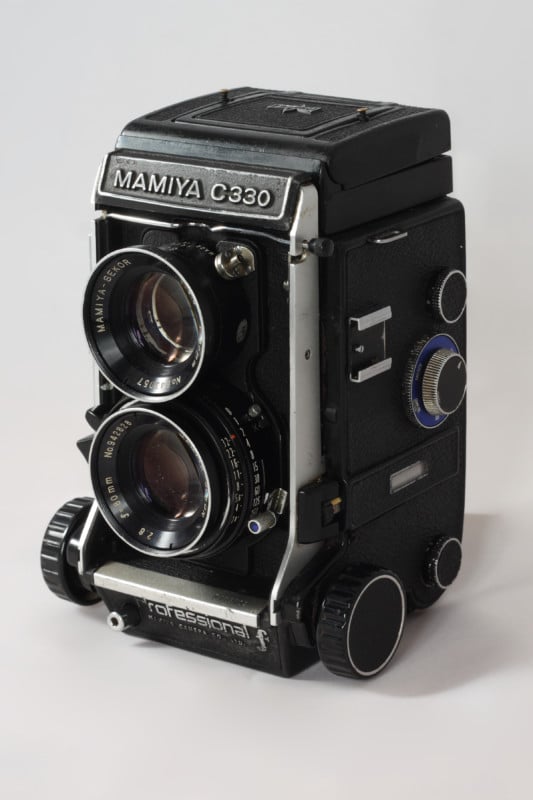
Starting in 1956, Mamiya began to produce its third series of TLRs, the Mamiya C series, which headlined one notable feature: interchangeable lenses. At the time, there was no other TLR with the ability to change lenses, and only one other was ever introduced — the Koni-Omegaflex.
The C-series started with the Mamiyaflex C and progressed to the Mamiyaflex C2, Mamiya C3, Mamiya C33, Mamiya C22, Mamiya C220, and Mamiya C330. The latter model, introduced in 1969, was an improved version of the C33 and the most complete and feature-packed of all the C-series models.
Like the other models, the C330 features an interchangeable finder (chimney style magnifier, eye-level prism, and the standard waist level), but now introduced the ability to change focusing screens as well, with six options to choose from.
All the C-series operate in the same general way. Focusing is done by rotating one of the two front-positioned knobs (one on the left, one on the right), which then extends the entire front assembly via a bellows system. Lenses can easily be swapped by unlocking the lens, which would raise a baffle flap in front of the film to prevent light leaks, and then releasing a retaining clip after which you could simply remove the lens assembly.
Since it is a TLR, each “lens” is really a lens block containing two lenses of equivalent focal lengths — a viewing lens on top and a taking lens with an integrated shutter on the bottom. Lens options range from a 55/4.5 to a 250/4.5, with the 80/2.8 being the “standard” option most commonly found paired with the cameras.
Along with the interchangeable ground glass focusing screens, the C330 is the only model that automatically cocks the shutter when advancing the film via the crank. It also features a revised parallax selector knob that now includes options for the 55mm, 65mm, and 250mm lenses.
If you’re looking for a cheaper option, you don’t lose a ton by going with the Mamiya C220 or even the Mamiya C33.
Premium: Rolleiflex 2.8/3.5 “Letter Model” Series
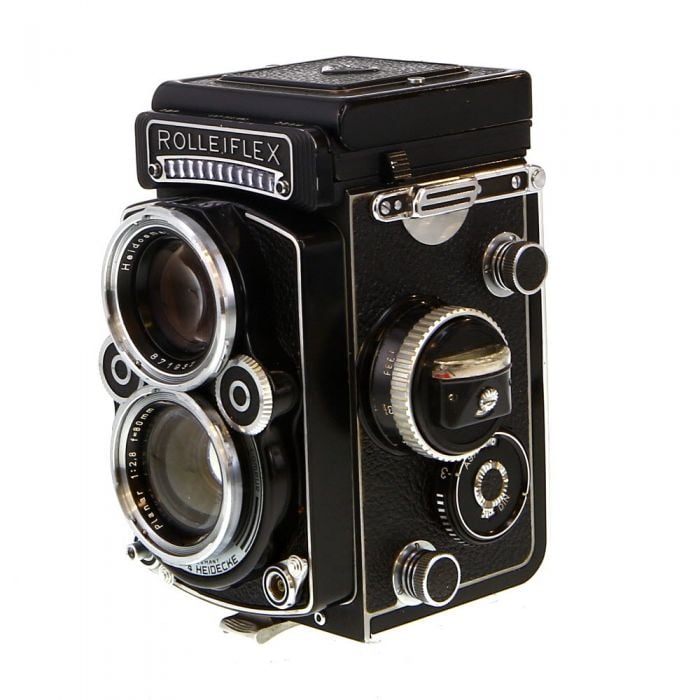
After World War II, the German company Franke & Heidecke, famous for its Rolleiflex and Rolleicord series of TLRs, found itself in recovery after a bombing raid destroyed its Braunschweig Factory. The Rolleiflex series had been on the market since 1928, so Franke & Heidecke decided to pivot to a slightly more premium design. Thus began the so-called “Letter Model” series, denoted by the use of a letter at the end — Rolleiflex 2.8A or Rolleiflex 3.5C, for example. The numbers denoted the f-stop, with the 2.8 series featuring the fastest f/2.8 lenses, unlike prior models (and those from other manufacturers) which were all f/3.5.
Like other Rolleiflex models (and unlike the more affordable Rolleicords), the Rolleiflex “Letter Model” series uses a crank winder to advance the film and simultaneously tension the shutter. A major change, however, was the move from a Zeiss Tessar lens to a more complex and superior Zeiss Planar design — some models also adopted a Schneider Kreuznach Xenotar lens. The only exception is the early Rolleiflex 2.8B, which was fitted with an 80mm Zeiss Biometar — this model is extremely rare.
While the 3.5 models continued with the use of 75mm lenses, the 2.8 series moved to 80mm. The difference is ultimately minor — about 37.5mm versus 40mm, in full-frame equivalence.
While all Rolleiflex models command a premium over most other TLRs, the Letter series does so at an even higher level. As you might imagine, the 2.8 models are even more expensive than the 3.5 series. But prices have risen quite a bit in recent years, so one could make the argument for them as both a tool and an investment. Plus, as good as the Zeiss Tessar lenses were, the Zeiss Planars were a step above.
Rangefinder Cameras
Budget: Koni-Omega Rapid Series
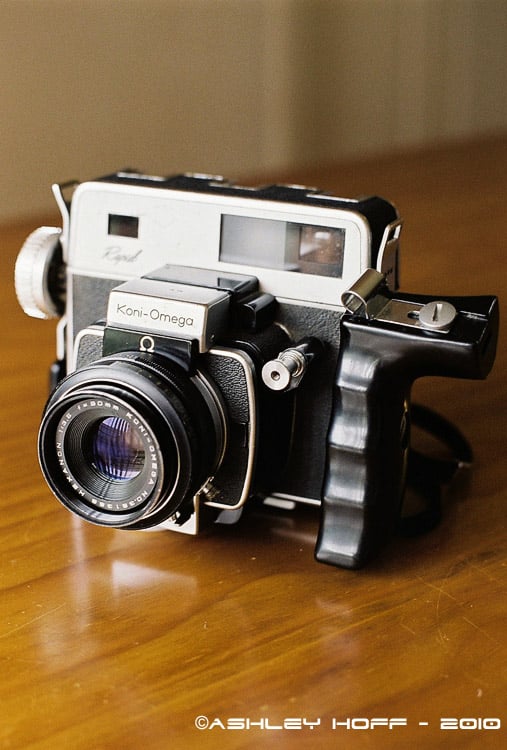
In 1954, Simmon Bros. N.Y., known for their line of enlargers, released the Omega 120 — a 6x7cm rangefinder camera with a 90/3.5 Omicron lens. The design of this camera was later acquired by Konica, which then produced a line of rangefinder press cameras that could capture ten exposures on a roll of 120 and 20 exposures on a roll of 220.
The cameras were fitted with a hand-grip on the left and the film was advanced via a pull-push mechanism on the right-hand side, allowing for very quick shooting (hence the name Rapid). Above the pull-push film advance is a large knob that moves the entire lens block via a rack-and-pinion system to focus. As the knob is turned, pins on the rear of the lens interact with a rangefinder focusing system, and the user determines focus via the rangefinder patch in the middle of the viewfinder.
The Koni-Omega Rapids are very fluid in use and quite lightweight compared to other 6x7cm cameras of the time, largely owing to the rangefinder design. The lens lineup is slim compared to medium format SLRs, but such is the nature of non-Leica rangefinders. The standard lens is a six-element/five group 90/3.5 Super Omegon or 90/3.5 Hexanon, yielding an approximate 45mm full-frame equivalent field of view.
Also available are 58/5.6 Hexanon, 60/5.6 Hexanon, 135/4.5 Hexanon, and 180/4.5 Hexanon. The Omega 120, Koni-Omega Rapid, and Koni-Omega Rapid M have 90mm and 180mm framelines, while the later Koni-Omega M, Rapid Omega 100, and Rapid Omega 200 have an additional frame line for the 135mm lens. The wider angle lenses require an external shoe-mounted viewfinder on all the models.
The best options are the later Rapid Omega 100 and Rapid Omega 200 — the latter allows for mid-roll film changes via its interchangeable magazine, much like the interchangeable backs of other medium format cameras.
Mid-Range: Fuji GS645 Professional Series

Fujifilm — despite producing over a dozen Fujica 35mm SLRs, a few Fujica medium format cameras, and many Fujica 35mm compact cameras — was mostly known for its 35mm, 120, and large format film. In the early 1980s, however, Fujifilm began production on new lines of fixed focus and autofocus 35mm compacts and moved from the “Fujica” moniker to simply “Fuji.” A number of these — the Fuji DL series, Fuji Cardia, and Fujifilm Klasse lines — found great success.
Around the same time, Fujifilm entered the high-end fixed-lens medium format rangefinder market with its series of Fuji GS, GW, and GSW cameras. These were produced in 6×9, 6×8, 6×7, and 6×4.5cm formats. The most affordable of these were the Fujica GS645 Professional and Fuji GS645S Professional Wide60 — there was also the Fujica GS645W Professional, but this was a scale focus camera without a rangefinder.
All three cameras share nearly identical bodies and capture images in the 6×4.5 format on either 120 or 220 film. They feature a lightweight, folding body, a bellows system for focusing, leaf shutter lenses with speeds from 1 to 1/500 of a second and a built-in LED light meter, powered by two LR44 (also known as A76 or SR44).
The Fujica GS645 Professional is distinguished by its 5 element EBC Fujinon S 75/3.4 lens and a 0.63x magnification rangefinder with parallax correction.
The Fujica GS645S Professional Wide60 was released the following year, fitted with a new EBC Fujinon W 60/4 Zeiss Orthometar-type lens with 7 elements in 5 groups. The 60mm lens (about 35mm full-frame equivalent) was chosen after the 45mm f/5.6 (about 28mm equivalent) lens of the scale-focusing GS645W was criticized as being too wide. Like the GS645, the camera has a parallax-corrected rangefinder, though with a slightly lower magnification of 0.5x.
Since these rangefinders transport the film horizontally, unlike most other 6×4.5 cameras which move vertically, images are captured in portrait orientation when the camera is held normally. This can take a little getting used to, especially if you primarily shoot in landscape orientation.
While not rangefinders, the Fujifilm GA645 series features a similar design (with a rangefinder-like viewfinder), but with the addition of autofocus. The Fujifilm GA645Zi is even fitted with a 55-90/4.5-6.9 zoom lens that moves in increments from 55 to 65 to 75 to 90mm. Unlike the rangefinders, these are motor-driven and entirely battery-dependent.
Premium: Plaubel Makina 67 / Plaubel Makina W67
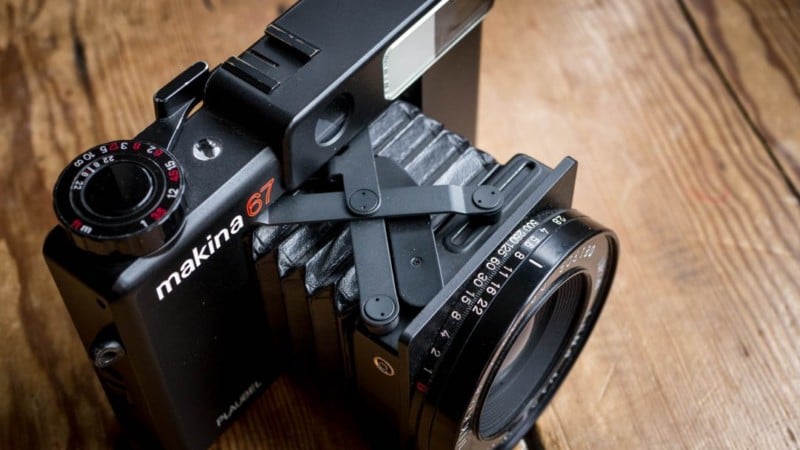
Plaubel, a German camera maker founded in 1902 by Hugo Schrader, became famous for the Makina series of press cameras, which were first introduced in 1911. By the 1970s, Goetz Schrader, the son of Hugo Schrader, decided to sell the company as he was growing old, and the Kimio Doi of the Japanese Doi Group purchased the company in 1975. Quickly thereafter, Doi had Plaubel begin the development of a new camera with a specially developed lens by Nikon.
The result was the Makinette 67, a prototype that premiered at Photokina in 1976. Doi, however, was not satisfied with the design and went back to the drawing board. He sought the help of Konica and enlisted Yasuo Uchida (designer of the Konica C35 EF “Pikkari”) as lead designer. The two primary requirements were that the camera shoot medium format and the lens had to be exceptional — compactness, durability, and ease of operation were also high on the list. There was some disagreement between Doi and Uchida: Doi wanted the camera to be automatic exposure, while Uchida wanted a lens from Konica instead of Nikon. Doi relented on the former, agreeing to a built-in light meter with manual controls, and Uchida accepted the Nikkor 80/2.8 lens (40mm equivalent) after testing a copy and finding it to be of extraordinary quality.
The end result was a strut folding rangefinder camera with a traditional film advance lever, shutter speed and aperture dials on the lens, and a somewhat odd, but extremely functional, focusing dial around the shutter release button. The location of this dial allowed the user to adjust the focus with their finger — aligning the rangefinder patch in the viewfinder as usual — and take a photo very easily and quickly.
Below the film advance lever on the back of the body is a small button that activates the light meter — a basic three LED readout in the finder window. Obviously, a battery is required to power the meter, but the rest of the camera remains fully mechanical.
The later Plaubel Makina W67 features a wider-angle Nikkor 55/4.5 lens (about 28mm equivalent) and a few design changes such as a ribbed body and rubber ring around the focus dial.
If you prefer an interchangeable lens camera, look toward the Mamiya 6 or Mamiya 7 — both highly regarded cameras, but completely different in design and operation to the Plaubel Makina 67. They’ll also cost you a fair bit more, especially the Mamiya 7, but you do gain advantages like the interchangeable lenses and aperture-priority autoexposure.
Image credits: Header photo licensed via Depositphotos.